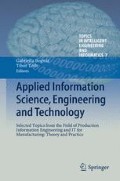Abstract
Natural language processing (NLP) is a well-known and increasingly more important area in human-computer interaction. Talking with a computer in human language is not very far away; for instance, there are automotive systems nowadays where people can control their car by voice, with some limitations. The goal of our research is to develop a natural language framework which will be used to extend existing systems with a natural language controlling capability. Our research focuses on the textual form of input; a proper speech recognizer or speech-to-text converter can produce textual commands and queries anytime. This chapter mainly deals with the optimization of algorithms in the most relevant modules of the framework: POS tagging and function mapping.
Access this chapter
Tax calculation will be finalised at checkout
Purchases are for personal use only
References
Aust, H., Oerder, M.: Dialogue control in automatic inquiry systems. In: Dalsgaard, P., Larsen, L., Boves, L., Thomsen, I. (eds.) Proceedings of the ESCA Workshop on Spoken Dialogue Systems, pp. 121–124. Vigso, Denmark (1995)
McTear, M.: Spoken Dialogue Technology: Enabling the Conversational User Interface, Distributed at the DUS/ELSNET Bullet Course on Designing and Testing Spoken Dialogue Systems, Springer, New York (1997)
McTear, M.: Modelling spoken dialogues with state transition diagrams: experiences of the CSLU toolkit. In Proceedings of the International Conference on Spoken Language Processing, Australian Speech Science and Technology Association, Incorporated, Sydney, Australia 4, pp. 1223–1226 (1998)
Hulstijn, J., Steetskamp, R., ter Doest, H., van de Burgt, S., Nijholt, A.: Topics in SCHISMA dialogues, In Proceedings of the Twente Workshop on Language Technology: Dialogue Management in Natural Language Systems (TWLT 11) pp. 89–99 (1996)
Veldhuijzen van Zanten, G.: Pragmatic interpretation and dialogue management in spoken-language systems, In Luperfoy, N., and V. van Zanten (eds.), Dialogue Management in Natural Language Systems, pp. 81–88, (TWLT11) University of Twente, Enschede (1996)
McTear, M.F.: Spoken dialogue technology: enabling the conversational interface. ACM Comput. Surv. 34(1), 90–169 (2002)
Klein, D., Manning, C.D.: Accurate unlexicalized parsing. In the Proceedings of ACL, pp. 423–430 (2003)
Loper, E., Bird, S.: NLTK: The Natural language toolkit. In Proceeding of ACL Workshop on Effective Tools and Methodologies for Teaching Natural Language Processing and, Computational Linguistics, pp. 62–69 (2002)
Zsibrita, J., Vincze, V., Farkas, R.: magyarlanc 2.0: szintaktikai elemzés és felgyorsított szófaji egyé. egyértelműsítés. In: Tanács Attila, Vincze Veronika (eds.): IX. MagyarSzámítógépes Nyelvészeti Konferencia. CityplaceSzeged, Szegedi Tu-dományegyetem, pp. 368–374 (2013)
Fossati, D., Di Eugenio, B.: A mixed trigrams approach for context sensitive spell checking. In: Proceedings of 8th International Conference, CICLing 2007, Mexico City, pp. 623–633, 18–24 Feb 2007
Trón, V., Kornai, A., Szepesi, Gy., Németh, L., Halácsy, P., Varga, D.: Hunmorph: open source word analysis. In: Software ’05 Proceedings of the Workshop on Software pp. 77–85 (2005)
Manning, C., Schütze, H.: Foundations of Statistical Natural Language Processing, MIT Publisher, Cambridge (1999)
Freitag, D., McCallum, A.: Information extraction with HMM structures learned by stochastic optimization. In Proceeding of AAAI (2000)
Lafferty, J.D., McCallum, A., Pereira, F.C.N.: Conditional random fields: probabilistic models for segmenting and labeling sequence data. In: Proceedings of the Eighteenth International Conference on Machine Learning (ICML 2001), pp. 282–289, Morgan Kaufmann Publishers, Burlington (2001)
Sutton, C., McCallum, A.: An Introduction to Conditional Random Fields. Now Publishers, Foundation and Trends in Machine Learning (2012)
Sha, F., Pereira, F.: Shallow parsing with conditional random fields. In: Proceeding of NAACL ’03 Proceedings of the 2003 Conference of the North American Chapter of the Association for Computational Linguistics on Human Language Technology, pp. 134–141 (2003)
Joshi, A., Levy, L., Takahashi, M.: Tree adjunct grammars. J. Comput. Syst. Sci. 10(1), 136–163 (1975)
Tesniere, L.: Elements de Syntaxe Structural, Publisher Kliencksieck, Paris (1959)
Hudson, R.: An Introduction to Word Grammar, Cambridge University Press, Cambridge (2010)
Paun, G.: Marcus Contextual Grammars, Kluwer Academic Publisher, Dordrecht (1997)
Dedin, A., Nagy, B.: Computing trees with contextual hypergraph grammars. In Proceeding of ForLing, pp. 39–53 (2007)
Nagy, B., Ottó, F.: Finite state acceptors with translucent letters. In: Proceeding of ICAART, pp. 3–31 (2011)
Nagy, B., Kovács, L.: Linguistic applications of finite automata with translucent letters. In: Proceeding of ICAART, pp. 461–469 (2013)
Acknowledgments
The described work was carried out as part of the TÁMOP-4.2.2/B-10/1-2010-0008 project in the framework of the New Hungarian Development Plan. The realization of this project is supported by the European Union, co-financed by the European Social Fund.
Author information
Authors and Affiliations
Corresponding author
Editor information
Editors and Affiliations
Rights and permissions
Copyright information
© 2014 Springer International Publishing Switzerland
About this chapter
Cite this chapter
Barabás, P., Kovács, L. (2014). Optimization Tasks in the Conversion of Natural Language Texts into Function Calls. In: Bognár, G., Tóth, T. (eds) Applied Information Science, Engineering and Technology. Topics in Intelligent Engineering and Informatics, vol 7. Springer, Cham. https://doi.org/10.1007/978-3-319-01919-2_3
Download citation
DOI: https://doi.org/10.1007/978-3-319-01919-2_3
Published:
Publisher Name: Springer, Cham
Print ISBN: 978-3-319-01918-5
Online ISBN: 978-3-319-01919-2
eBook Packages: EngineeringEngineering (R0)

